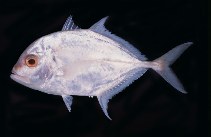| Family: |
Carangidae (Jacks and pompanos), subfamily: Caranginae |
| Max. size: |
60 cm TL (male/unsexed) |
| Environment: |
reef-associated; marine; depth range 20 - 140 m, amphidromous |
| Distribution: |
Indo-West Pacific: east coast of Africa (without verified records from the Red Sea) to Sri Lanka and farther eastward to the Gulf of Thailand, north to Japan and south to Australia. |
| Diagnosis: |
Dorsal spines (total): 9-9; Dorsal soft rays (total): 20-23; Anal spines: 3-3; Anal soft rays: 17-19. Description: Body strongly compressed. Dorsal profile of head strongly elevated to nape, nearly straight. Body bluish grey dorsally, shading to silvery on sides with small black spot on upper rear margin of opercle (Ref. 90102). Lateral line with 19-36 weak scutes and 31-35 total elements (including anterior scales). Pectoral fins falcate; 1st dorsal lobe slightly falcate. No scales on breast to behind pelvic origin and laterally to pectoral base, including the small area anteriorly just above fin. |
| Biology: |
Adults occur in the continental shelf, near rocks and coral reefs (Ref. 7300). They feed on crustaceans, small squids, and fishes (Ref. 5213). Juveniles are found in sandy bays (Ref. 2334). Marketed fresh, may be dried or salted (Ref. 5284). |
| IUCN Red List Status: |
Least Concern (LC); Date assessed: 09 March 2015 Ref. (130435)
|
| Threat to humans: |
harmless |
Source and more info: www.fishbase.org. For personal, classroom, and other internal use only. Not for publication.

